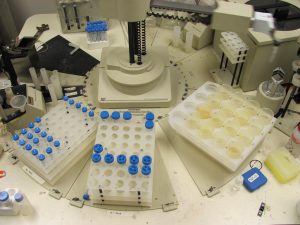Lab facilities and equipment
The cosmochemistry laboratory at SSL is designed for the separation of cosmogenic radionuclides from extraterrestrial and terrestrial samples. Our lab consists of 5 rooms with 3 regular fume hoods, 2 perchloric acid fume hoods and 2 laminar flow hoods. The clean laboratory is suitable for handling and preparation of less than 100,000 atoms of cosmogenic nuclides from a variety of samples within a contamination-free environment. Meteorites, lunar samples and terrestrial quartz samples are dissolved in concentrated HF/HNO3. After dissolution, cosmogenic radionuclides are separated using ion exchange chromatography and solvent-solvent extraction techniques.
We also have the capability to measure the bulk composition of microgram to gram sized samples using Inductively Coupled Plasma Optical Emission Spectroscopy (ICP-OES) and Inductively Coupled Plasma-Mass Spectrometry (ICP-MS).
Terrestrial rocks. For the analysis of cosmogenic radionuclides (mainly 10Be and 26Al) of terrestrial rocks, we generally first separate quartz from bulk rocks. To separate and purify the quartz we use two large ultrasonic tanks. The purified quartz is then dissolved in a HF/HNO3 mixture and run through the same procedures as extraterrestrial samples.
Ice cores. One of the five lab rooms is dedicated to ice core chemistry. For the chemical purification of the beryllium fraction, we use a Zymark robot.

Zymark robot purifies samples before isotopic analysis by AMS
Chemical analysis. For the chemical analysis of all dissolved samples, we use a Thermo-Fisher iCap 6300 ICP-OES, and an Agilent 8800 ICP-MS. In addition, we share a Tescan Vega3 Scanning Electron Microscope (SEM) with the Stardust group. The SEM is mainly used to analyze and map surface contamination on the Genesis foils and to do semi-quantitative chemical analysis of small particles, including micrometeorites and lunar regolith grains.